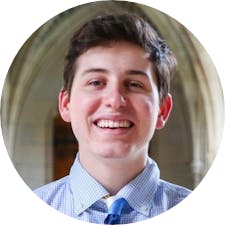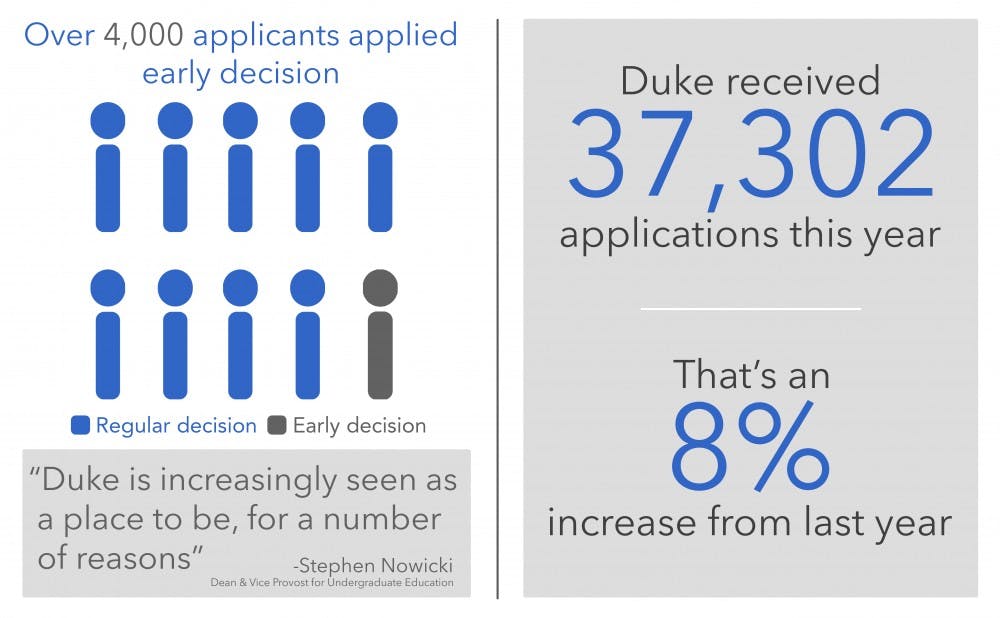For the fourth year in a row, Duke has broken its record for number of applications received with 37,302, an eight percent increase from the previous year.
There were just over 4,000 applicants who applied for early decision, of which 875 were accepted—both records. The class of 2022 had nearly 3,000 more applicants than the previous year's class, and about 5,500 more than the applicant pool five years ago. Stephen Nowicki, dean and vice provost for undergraduate education, said he believes the reason for the upward trend is simple.
“Duke is increasingly seen as a place to be, for a number of reasons,” Nowicki said. “We’re obviously a top ranked school, but I think that students are smart enough to realize that rankings aren’t everything.”
He said differences in scoring between top-ranked schools are minuscule, so students are instead attracted to Duke’s focus on cross-disciplinary teaching and programs, citing examples such as Bass Connections and DukeEngage.
The number of students of color applying has also driven the application increase, noted Christoph Guttentag, dean of undergraduate admissions.
“Most of the changes have been in the area of outreach to traditionally underserved or underrepresented students—our partnership with QuestBridge, our increased work with [the Knowledge is Power Program], our visits with [community-based organizations] during our fall recruitment travel,” he said.
QuestBridge connects successful low-income students to top universities, and KIPP is a non-profit network of charter schools in underserved areas across the country.
This year marked record-setting application numbers for some of Duke’s peer institutions as well. Harvard College matched Duke’s eight percent growth with 42,742 applicants for the class of 2022. Yale College saw a seven percent increase with 35,305 applicants, while Northwestern University had 40,418 applicants, up 8.5 percent from the previous year.
More students casting a wide net boosts the number of applicants across top institutions. Nowicki said that students are taking advantage of the Common Application to apply to as many schools as they can. This practice, he said, creates an unfortunate positive feedback loop where the number of applications rise at top schools and acceptance rates subsequently drop, so anxious students apply to more schools.
A lower proportion of regular decisions students apply to Duke with as high a level of interest as that shown by early decision applicants—one reason why Duke favors early decision applicants, who are bound to attend Duke if admitted, Nowicki added.
“[Early decision] students have thought about where they want to go and why,” he said. “They’re not hedging their bets, they’re not saying, ‘I’m going to throw the dart at the wall and whatever school has the highest rank that I happen to get into, that’s where I’m going to go.’”
Five years ago, the administration decided to gradually attract more early decision applicants and expand the percentage of each class accepted through early decision, Nowicki said.
For the class of 2017, 757 students were accepted through early decision and 3,062 through regular decision. As for the class of 2021, those numbers were 864 and 2,423 applicants respectively.
Nowicki noted that traditionally early decision applicants have been less diverse, wealthier and slightly weaker students. However, he pointed out efforts Duke has made to strengthen the early decision applicant pool, including better marketing of the need-blind admissions and partnerships with QuestBridge and KIPP.
The administration agreed to only increase the size of the early decision class if it was as strong as the regular decision class from the year before, Nowicki noted, adding that he believes the number of students admitted through early decision has plateaued.
As to whether overall application numbers will continue rising, Nowicki offered a skeptical prediction.
“I think we will reach an asymptote in terms of the total number of applications that schools like Duke get," he said. "Our applications might tail off a little slower than others do, but psychologically, I think that notion of bet-hedging will get to the point that people will not continue to apply to more and more schools.”
Get The Chronicle straight to your inbox
Signup for our weekly newsletter. Cancel at any time.

Jake Satisky is a Trinity senior and the digital strategy director for Volume 116. He was the Editor-in-Chief for Volume 115 of The Chronicle.

